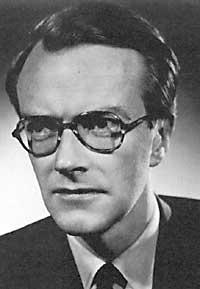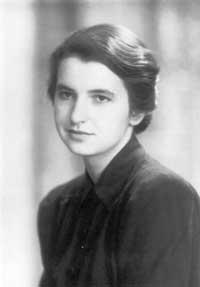"The parents of needs are inventive and not reversed"
2003/02/11 Carton Virto, Eider - Elhuyar Zientzia
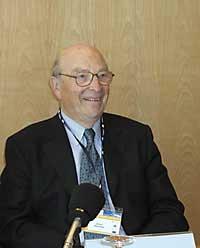
Arthur Körnberg was a student of Severo Ochoa at the New York College of Medicine and told him his love of enzymes. In fact, Körnberg used the enzymes to obtain a small chain of in vitro DNA and a long molecule.
The structure of DNA was still unknown, although it knew it played a fundamental role in inheritance. But Körnberg was not induced by structures or legacies to investigate DNA, because he was in love with enzymes. His teachers were the first to add sugar units and stretch polymers like starch, and based on his work, Arthur Körnberg wanted to do the same with the DNA chain. "I wasn't working for Watson and Crick's research, I just wanted to find enzymes," he said at the press conference.
First DNA chain
Körnberg discovered what he was looking for in the years 1954-55: The enzyme was able to lengthen the DNA chain. But he did not make a simple discovery, "that enzyme needed the four bases and the DNA chain itself to work." This discovery opted, in a way, for the structure proposed by Watson and Crick, but also more. "We clarified not only the copy of DNA but the machinery that allowed to repair DNA," said Körnberg. "Following the enzymes, we managed to better understand biological processes."
In his intervention in the Euskalduna Palace he spoke little about his research. More focused on the revolution of genomics and biotechnology. "When we began to investigate DNA, few imagined the XX. He confessed that he would become the symbol of science of the twentieth century." "30 years ago I would not have announced biotechnology."
Körnberg dedicated himself to it to ask for more money and effort to basic research.
Without planning
He said that the history of science is filled with unexpected discoveries and that for a long time the planning of science was a lack of planning. "The future cannot be predicted, but basic research is a guarantee of the future," he said.
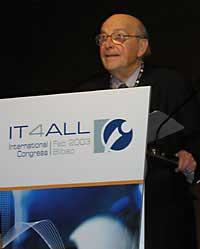
He commented that biotechnology has had a great influence on basic research and that this concerns him. According to him, in biotechnology there has been a lot of money and there is a risk that the business will prevail over research, that the industry will impose research.
For Körnberg, research cannot be left in the hands of the industry, "they are to make money and, therefore, governments must assume responsibility for carrying out a basic investigation." In the long term.
After these words, however, the European strongly criticized the attitude that has prevailed in Europe to transgenic foods. He literally said that "Europe is paralyzed by its attitude towards transgenics." He also said genetic engineering is safe and is the only option to feed the third world. It seems that biotechnology companies do not have any kind of hunger for money.
The discovery of DNA 50 years later
After the conference of Arthur Körnberg, a round table was held. In it, transgenic foods were cited again. Round table with Hans Jörg Rheinberger, Brenda Maddox and Robert C. They were Olby, and according to the latter, transgenic reflections are deeper than if or not: "We must decide to what extent human beings want to transform nature."
Robert Olby has researched genetics and molecular biology and is currently professor emeritus at the Philosophy and History of Science department at the University of Pittsburg. However, it is British at the round table that showed a certain sense of humor with birth.
After the presentation of the structure of DNA, he spoke of the impact that the discovery itself had on scientific journals in the coming years. He graphically explained the finding of Watson and Crick in the articles references of the journals Science and Nature of the coming years, and surprisingly the figures were not very high.
The discovery that has subsequently been considered as the milestone of science did not produce as much follow-up among DNA researchers. Of all the research that was published on DNA, very few made reference to the structure.
Dark woman of DNA
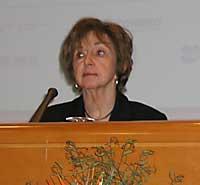
Before Olby spoke journalist Brenda Maddox. Maddox has written the biography of Rosalind Franklin, a woman who, despite being fundamental to finding the structure of DNA, has been forgotten by history.
Watson called him in his book the dark woman of DNA and, pulling her, Maddox remakes a history of tensions. Franklin was a very smart woman and, to a large extent, she owed Watson and Crick the structure of DNA, but Franklin had a very bad relationship with Maurice Wilkins, another researcher at King's College, who mistakenly stole the results and gave them to the other two. Franklin died very young from cancer and received fame and Nobel Prize winner Watson and Crick with Wilkins.
The trio of the morning round table was formed by Hans Jörg Rheinberger, director of the Max Planck Science History Institute in Berlin. Rheinberger spoke, among other things, of the history and expertise of DNA research. His opinion was critical. For example, he criticized the Human Genome project, which announced the end of the research before its completion and made public what should be in the scientific field.
Throughout the morning, a guest who was not in the Euskalduna Palace also participated. Francis Crick could not come and welcomed us with a video.

Gai honi buruzko eduki gehiago
Elhuyarrek garatutako teknologia




